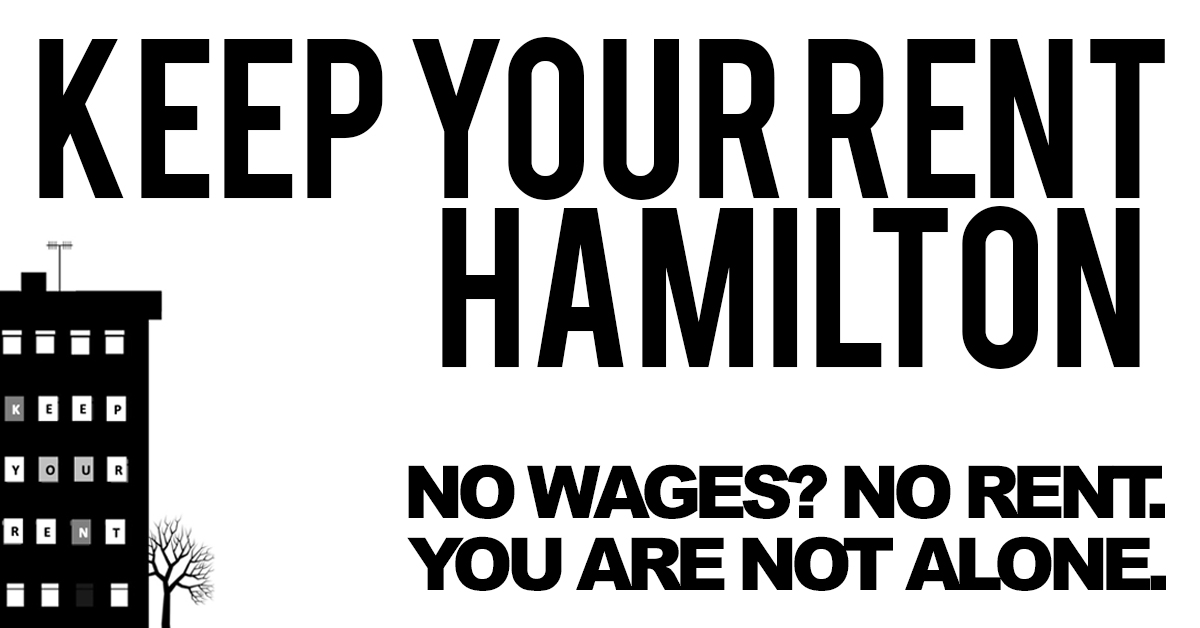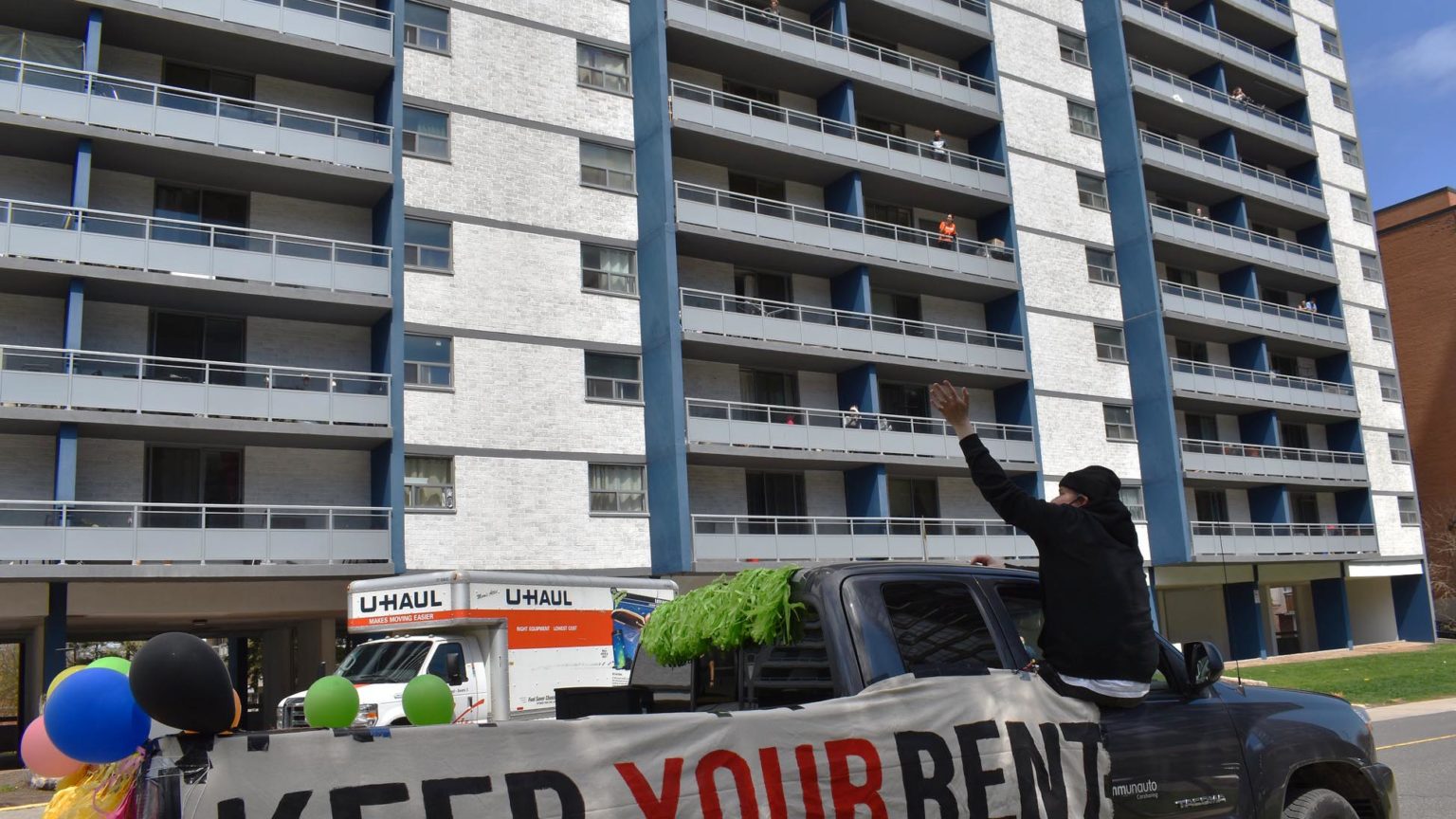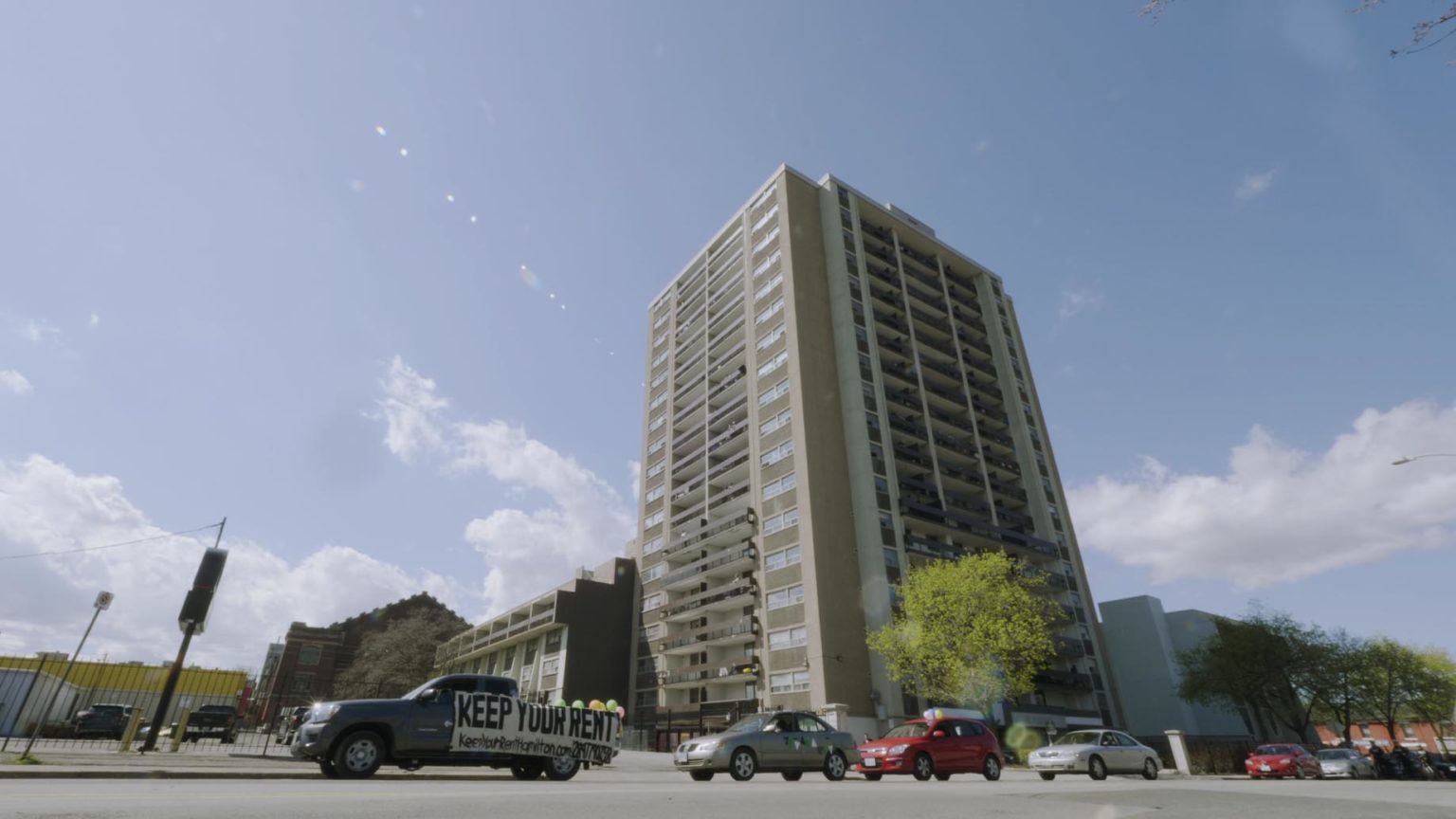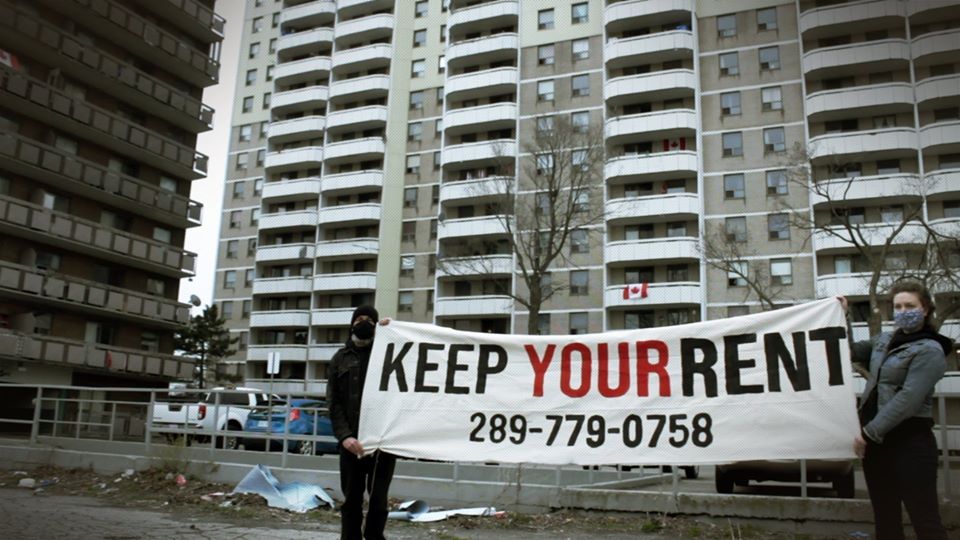An organizer with Keep Your Rent Hamilton reflects on their rent strike campaign and May Day outreach efforts. This article was previously published on North Shore Counter-Info and It's Going Down.

The first of May is celebrated in most countries around the world—and by North American leftists—as May Day, or International Workers Day. For most working-class people in Hamilton, however, this year it had a more urgent significance. For the second time since the beginning of the COVID-19 crisis, rent was due.
Rent day can be a source of stress at the best of times. And these are far from the best of times. Over the past two months, millions of workers across Canada have been laid off or had their hours cut. Nearly one in five Canadians are now receiving the Canada Emergency Response Benefit (CERB), a temporary federal income support that offers two thousand dollars a month in taxable income to those who have lost work as a result of the pandemic. For people in Ontario earning $48,535 or less per year, the payment works out to $1590 per month after taxes. It’s already been pointed out [in the Toronto Star] that this isn’t sufficient to cover the current market rent of a one-bedroom apartment in cities like Toronto and Vancouver. In Hamilton, the CERB will cover rent… barely. But beyond that, there’s not much room left over for luxuries such as food, medicine or other basic necessities. Shockingly, this hasn’t stopped landlords from staking their claim to their tenants’ cheques anyway.
Driven by this dire state of affairs and the gloomy economic forecast, calls for tenants to keep their rent have started gaining traction in several cities across Ontario. Campaigns have emerged, structured around the fact that millions of tenants have lost their primary source of income, and are simply not in a position to pay. Day-to-day organizing in these campaigns has involved reaching as many people as possible, discussing any fears or concerns they have, taking down their information, connecting them with neighbours who are in the same position, and encouraging them to build local defence organizations aimed at protecting their members from evictions and other forms of landlord retaliation.
A similar dynamic has been unfolding in cities and neighbourhoods around the world. Here in Ontario, the epicentre of this loosely-structured movement has been Toronto. The Keep Your Rent campaign first launched in mid-March by Parkdale Organize has since spread to several other downtown neighbourhoods, and to the suburbs of Etobicoke, East York and Scarborough. Keep Your Rent chapters have also popped up in Ottawa, Guelph and Hamilton. Organizers in Kingston have instead opted to follow their counterparts in Montreal in framing their campaign as a rent strike. While organizers in each city have had to contend with local dynamics and material conditions, the nature of Canada’s heavily financialized rental market and the peculiarities of the COVID-19 crisis itself have created the basis for shared experimentation in tactics. This has been particularly important as it relates to outreach, as it has become necessary to come up with creative new methods of communicating and passing information while adhering to social distancing protocols.

An online promo graphic for Keep Your Rent Hamilton that reads: “No Wages? No Rent. You Are Not Alone”
The Hamilton Keep Your Rent campaign went public on March 30. This late start meant that organizers weren’t able to generate much of a buzz for April 1. Our initial outreach strategy involved a coordinated city-wide postering blitz encouraging people to get in touch via our website and/or a hotline staffed by volunteers. The tail end of March and first few days of April saw a high volume of calls – a healthy mix of anxious tenants, curious pedestrians and pissed off landlords. We also received a flurry of social media messages from a small, yet vocal group of online commenters expressing their outrage at our suggestion that tenants should consciously withhold rent, their belief that for tenants to do so would be courting certain mass eviction, and their overriding concern for the plight of small landlords. This latter framing of landlord/tenant relations has long been used by the landlord lobby – represented provincially by the Federation of Rental Providers of Ontario (FRPO) and locally by the Hamilton District Apartment Association (HDAA) – as a way of humanizing an industry dominated by multi-million dollar corporations. But it was disappointing, and a bit surprising, to see these lines so readily parroted by other tenants.
By mid-April, in an effort to expand and better focus our outreach, organizers with Keep Your Rent Hamilton decided to experiment with using amplified speeches in some of the denser clusters of high-rise apartment buildings in the city. The idea brought to mind the populist caricature of an old-timey mayoral candidate driving around working-class districts with a truck and a loudspeaker, so we decided to embrace the aesthetic and adapt it to our own purposes. To this end, we constructed some oversized papier-mâché Doug Ford and Monopoly Man heads, in a nod to the 1946 Hamilton Stelco Strike. We recorded a folksy speech looped over a familiar ice-cream truck jingle. And on Saturday April 25, we decorated a pick-up truck with banners and balloons, loaded it up with a loudspeaker, and set off.
The plan was to start with a test run in the truck, visiting a few buildings in the downtown core. Throughout the following week, we would carry out ‘pop-up’ speeches, with smaller groups of people using a banner and megaphones to hit up buildings in more remote parts of the city. We’d then cap things off with a ‘Keep Your Rent Convoy’ on May Day.
The first action ended up being a useful dry run. It began with a meet-up at a parking lot near Queen and York, just down the street from a pair of massive high-rises that loom over the surrounding block. After a quick check in, we put on the giant heads, switched on the loudspeaker and started the short drive over to the towers, the truck flanked by a car and a few people on bikes—everyone keeping their distance. The towers at 151 and 155 Queen Street North, dubbed ‘The Village’, are home to a large concentration of immigrant families, a number of whom have shared experiences of neglected repairs and racist treatment at the hands of their landlord, Victoria Community Homes–a non-profit that manages a large part of the city’s social housing stock, and generally operates as a slum lord.

An organizer with Keep Your Rent Hamilton waving at tenants in the Oakland Towers.
As we drove up to the buildings, amused neighbours began coming out onto their porches, cellphones in hand, to record the spectacle. We decided to pull into the back parking lot off Oxford St, as it offered a good vantage point from the balconies of both buildings. Immediately upon pulling into the lot, a wiry and incredibly agitated young man started shouting at us that the cops had already been called. He followed up by loudly complaining: “You’re making my job harder. I have to collect rent from these people!”
Undeterred by the property manager’s whinging, one of the members of our group read a prepared speech through the loudspeaker, explaining who we were, why we were there, and why we believed that tenants living in the buildings should keep their rent. As we were wrapping up and getting ready to leave, a police cruiser pulled up and blocked our exit. We were temporarily detained, officially for trespassing. The first officer on the scene was a hot-headed, take-charge type, who seemed as though he’d been enjoying the extra ticketing powers he’d been gifted by the COVID-19 crisis. A couple more cruisers soon showed up, and the other cops seemed to realize how ridiculous the whole scene looked. After about twenty minutes of back and forth, we were released without incident.
We quickly regrouped, then set off for our next stop: the buildings at 150, 155 and 160 Market Street. These three high-rises are all owned by Northview REIT, a $4 billion company that has subjected their tenants to multiple Above Guideline rent Increases (AGIs) over the past years, a process that they describe to their investors as a “Strategic Value Creation Initiative”. One of these AGIs was the basis of a multi-building organizing campaign back in 2016. Tenants ultimately failed to stop the increase, but managed to get a couple percentage points shaved off by proving that contractors had charged them for renovations they’d never actually done.
When we pulled up to the buildings, a handful of people were already standing out front, and many more soon came out onto their balconies. As a second speaker read out the same prepared speech, substituting in some choice details about Northview, many of those on their balconies cheered. When the speech ended, the corridor between the buildings briefly echoed with applause and tenants shouting their approval.
After leaving Market Street, we again reconvened at a nearby parking lot. Following a hasty debrief, most of the group decided to call it a day. The run-in with the cops, and a later-than-hoped start time had stretched things out longer than we’d expected. The Monopoly Man head had caught some wind and cracked, and the consensus was that the whole idea needed a bit of a rethink. Those in the truck decided to end things off with a quick spin around Durand and Corktown, two of the most densely populated neighbourhoods in Hamilton. Even without the papier-mâché heads, residents of these neighbourhoods seemed to get a kick out the truck and the looped recording, with many drivers honking their horns in support, and more people waving and shouting from their balconies.
The following week, we broke up into smaller groups of three and carried out ‘pop-up’ actions at other high-rise clusters around the city. We aimed for a window between 5-7pm. Two people would hold a banner, while the third gave a speech through a megaphone. This was done on three separate occasions, in different parts of the city, and each time, participants described similar experiences. At many of the buildings, one or two hecklers would shout during the speech for our group to shut up and go away. At two buildings, eggs were thrown (both times they missed). But after the speech was over, every building lit up with applause and cheers from the tenants who had assembled on their balconies.

The convoy arriving at its last stop of the day, outside 181 John Street North.
While there are clear limitations to shouting a speech at a building full of people through a megaphone (issues around translation being a big one), this approach did feel more intimate than the stops we’d done with the truck and loudspeaker. Several residents on lower floors used the opportunity to engage us in conversations or debates, and we were able to see a number of tenants having similar discussions with their neighbours across their balconies. As we were leaving a cluster of eight high-rise buildings near King and Cochrane, one of the participants joked that it had been the easiest tenant outreach that he’d ever done, and that he couldn’t believe he’d wasted so many hours actually knocking on people’s doors. Obviously it’s no substitute for the level of conversation that you can have with a person one-on-one at their doorway, but it’s also true that there’s something to be said about being able to get a message out to hundreds of people in one go.
At around 12:30pm on Friday May 1, we began assembling at a downtown parking lot near Jackson Square. By one o’clock we’d assembled a crew of around five or six cars, all decked out with banners, signs, and decorations. Not a massive convoy, by any means, but enough for our purposes. No press had bothered to show up, despite our best efforts. We were joined by an ACTION Team van (Addressing Crime Trends In Our Neighbourhood, Hamilton’s community policing outfit), a couple of unmarked cruisers and three bike cops, who kept an eye on the situation from the other side of the lot. A decision had been made to leave the Doug Ford head at home, and to avoid having anyone ride in the back of the pick-up with the sound system. This was done as a safety precaution, and to avoid giving the cops a reason to stop and ticket us.
At around 1:30 we set out, driving slowly down Market Street and past the buildings we’d visited the weekend before. The convoy then turned south onto Queen and headed towards Durand. We did a slow loop of the neighbourhood before heading back towards Queen Street, stopping outside 175 Hunter Street West, one of two large high-rises on that block owned by Timbercreek Asset Management. We blasted a prerecorded speech calling attention to Timbercreek’s business model, their portfolio of more than $10 billion in assets, and the central role they’d played in displacing a large immigrant community from the Ottawa neighbourhood of Herongate. This building happened to be located across the street from the headquarters of Hamilton’s main cable news channel, CHCH. Hearing the commotion just outside their windows, they belatedly decided to scramble a news van to get some footage and follow us around for a few blocks. We continued our drive through Durand, our calls for tenants to keep their rent echoing off the tall buildings that lined the streets.
At two o’clock we stopped at the Corktown meet-up point, a parking lot on the corner of Young and Hughson, where we were joined by another couple of cars. From there we played another prerecorded speech, this one targeting Starlight Investments, owner of the four Villa Marie Towers located at 151 Hughson Street South, 50 Young Street, and 43 and 57 Forest Avenue. We pointed out that Starlight’s CEO and President Daniel Drimmer is one of the most powerful real estate investors in Canada, with ties to the American real estate investment firm Blackstone Group—the single largest landlord in the world. While we didn’t get much initial reaction from the buildings’ residents, the reception in the neighbourhood warmed up considerably when we hit the streets and began blaring the recorded loop.
After a quick drive through Corktown, our next stop was the Oakland Towers, two buildings located at 100 Forest Avenue and 213 Charlton Avenue East. We played another speech outside the Charlton building, this time targeting the buildings’ owner, Effort Trust – a private, family-run company that owns or manages over 80 apartment buildings in Hamilton, making them the largest landlord in the city. As the recording played, dozens of people came out on their balconies to wave and cheer us on, creating one of the most memorable scenes of the day.
At 2:30 we re-assembled at the Central Memorial Community Centre, in Stinson, where we picked up another couple of cars, bringing our total to around ten vehicles. After briefing the new arrivals on our plans for the rest of the day, we set out to finish the last leg of our trip. This winding route took us back into Corktown (north of the GO Transit tracks), through Stinson, and north through Gibson. We stopped to give a speech at 150 Sanford Avenue North, whose residents got super fired up, providing another clear highlight of the day. In our speech we detailed the recent history of the building, which has suffered from a series of neglectful slumlords, and finished up with some details about the building’s current owner, Westbury Rental Residencies, and its sleazy property manager, Adam Kitchener.

Two organizers from Keep Your Rent Hamilton pose holding a banner, before addressing tenants at 221 and 225 Melvin Avenue.
Next we took the convoy west on Barton Street East, through Landsdale and then wound our way through Beasley. We delivered our final speech of the afternoon outside the complex at 181 John Street North, 192 Hughson Street North, and 44 Robert Street, pointing out the various dirty tricks that the buildings’ owner, Greenwin Inc, has used in their effort to socially cleanse the buildings – from offering cash buy outs, to water and electricity shut offs, to AGIs and ultimately an attempt to have a bunch of the three-bedroom units cut up into multiple bachelor and one-bedrooms.
At around 3:45 we pulled into the parking lot of the Beasley Community Centre, gave some closing statements, and dispersed. The crew in the pick-up and one other car decided to drive out to the east end to pay a quick visit to the Valery Homes complex in Rosedale/Bartonville, but not much came of it.
As we got home and checked the Keep Your Rent voicemail, we saw that our phone lines had lit up during the course of the convoy, with most of the calls coming from tenants in Corktown and Durand— neighbourhoods where we’re hoping to help build a local Keep Your Rent neighbourhood committee.
In debriefing the event, everyone agreed that the May Day convoy had been a success. It went off smoothly without any technical hitches, served as a fun way of raising the campaign’s profile, provided a safe new method of conducting outreach during the COVID-19 crisis, was well-received by community members, and led to more tenants reaching out to connect with the campaign. That said, in the discussions that have followed, we agreed that these types of multi-vehicle convoys are likely to be employed more often as a stand-in for traditional protests and marches in the coming weeks and months, and that we should avoid using the tactic again as an outreach strategy. We’d still recommend it as an option for organizers in other cities who are struggling to get a local campaign off the ground. And locally, we think that there’s continued utility in the smaller ‘pop-up’ tactic of using a banner and megaphone to address residents of a particular building, particularly as this is something that other tenants can easily reproduce in their own neighbourhoods.
The actions taken in the week leading up to May 1 were just a small part of a broader campaign. Of course, any success in defending one another from evictions and pushing for rent forgiveness will take more than feel-good actions and publicity stunts. It will take sustained organizing, carried out by people in buildings and neighbourhoods all across the city. For our part, organizers with Keep Your Rent Hamilton plan to build on the new contacts we made through this process, as we shift our focus towards helping to create and strengthen local organizing committees at the building and neighbourhood level.
If you’re interested in getting involved, check out our website https://keepyourrenthamilton.com, email us at [email protected] or call/text us at 289-779-0758.






Comments